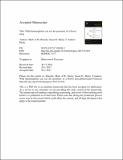Files in this item
Wild hummingbirds can use the geometry of a flower array
Item metadata
| dc.contributor.author | Hornsby, Mark A. W. | |
| dc.contributor.author | Healy, Susan D. | |
| dc.contributor.author | Hurly, T. Andrew | |
| dc.date.accessioned | 2018-02-02T00:31:44Z | |
| dc.date.available | 2018-02-02T00:31:44Z | |
| dc.date.issued | 2017-06 | |
| dc.identifier | 249062957 | |
| dc.identifier | 3fc6c02f-02d9-4142-8905-819404524f3f | |
| dc.identifier | 85011573340 | |
| dc.identifier | 000401205100006 | |
| dc.identifier.citation | Hornsby , M A W , Healy , S D & Hurly , T A 2017 , ' Wild hummingbirds can use the geometry of a flower array ' , Behavioural Processes , vol. 139 , pp. 33-37 . https://doi.org/10.1016/j.beproc.2017.01.019 | en |
| dc.identifier.issn | 0376-6357 | |
| dc.identifier.other | RIS: urn:9287504D4643D068B120216C62E6EB19 | |
| dc.identifier.other | ORCID: /0000-0002-8059-4480/work/60631326 | |
| dc.identifier.uri | https://hdl.handle.net/10023/12652 | |
| dc.description | This research was supported in part by ASAB to SDH, and a Natural Sciences and Engineering Research Council of Canada Discovery Grant to TAH. | en |
| dc.description.abstract | Animals use cues from their environment to orient in space and to navigate their surroundings. Geometry is a cue whose informational content may originate from the metric properties of a given environment, and its use has been demonstrated in the laboratory in nearly every species of animal tested. However, it is not clear whether geometric information, used by animals typically tested in small, rectangular boxes, is directly relevant to animals in their natural environment. Here we present the first data that confirm the use of geometric cues by a free-living animal in the wild. We trained rufous hummingbirds to visit a rectangular array of four artificial flowers, one of which was rewarded. In some trials a conspicuous landmark cued the reward. Following array translocation and rotation, we presented hummingbirds with three tests. When trained and tested with the landmark, or when trained and tested without it, hummingbirds failed to show geometric learning. However, when trained with a landmark but tested without it, hummingbirds produced the classic geometric response, showing that they had learned the geometric relationships (distance and direction) of several non-reward visual elements of the environment. While it remains that the use of geometry to relocate a reward may be an experimental artefact, it is one cue that is not confined to the laboratory. | |
| dc.format.extent | 5 | |
| dc.format.extent | 492204 | |
| dc.language.iso | eng | |
| dc.relation.ispartof | Behavioural Processes | en |
| dc.subject | Geometry | en |
| dc.subject | Selasphorus rufus | en |
| dc.subject | Hummingbirds | en |
| dc.subject | Landmarks | en |
| dc.subject | Spatial orientation | en |
| dc.subject | Navigation | en |
| dc.subject | QH301 Biology | en |
| dc.subject | NDAS | en |
| dc.subject.lcc | QH301 | en |
| dc.title | Wild hummingbirds can use the geometry of a flower array | en |
| dc.type | Journal article | en |
| dc.contributor.institution | University of St Andrews. School of Biology | en |
| dc.contributor.institution | University of St Andrews. Institute of Behavioural and Neural Sciences | en |
| dc.contributor.institution | University of St Andrews. Centre for Social Learning & Cognitive Evolution | en |
| dc.contributor.institution | University of St Andrews. Centre for Biological Diversity | en |
| dc.identifier.doi | https://doi.org/10.1016/j.beproc.2017.01.019 | |
| dc.description.status | Peer reviewed | en |
| dc.date.embargoedUntil | 2018-02-01 | |
| dc.identifier.url | http://www.sciencedirect.com/science/article/pii/S0376635717300463 | en |
This item appears in the following Collection(s)
Items in the St Andrews Research Repository are protected by copyright, with all rights reserved, unless otherwise indicated.

